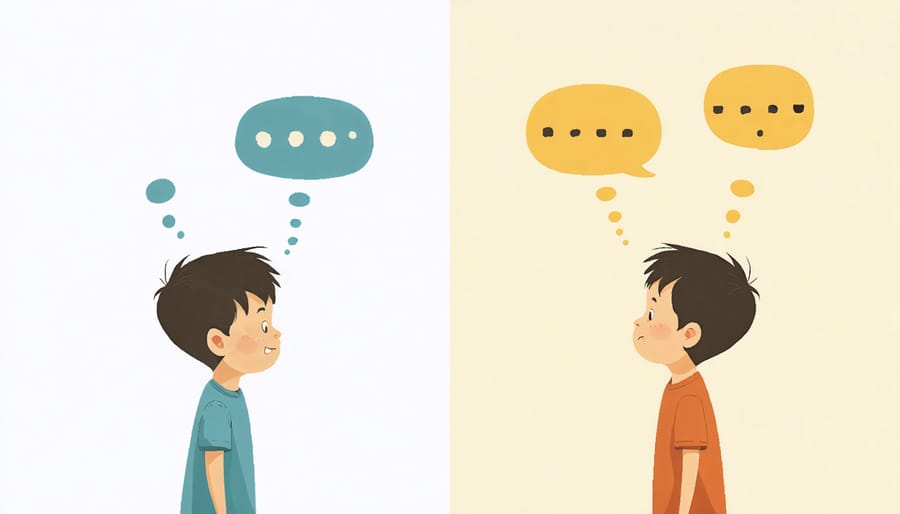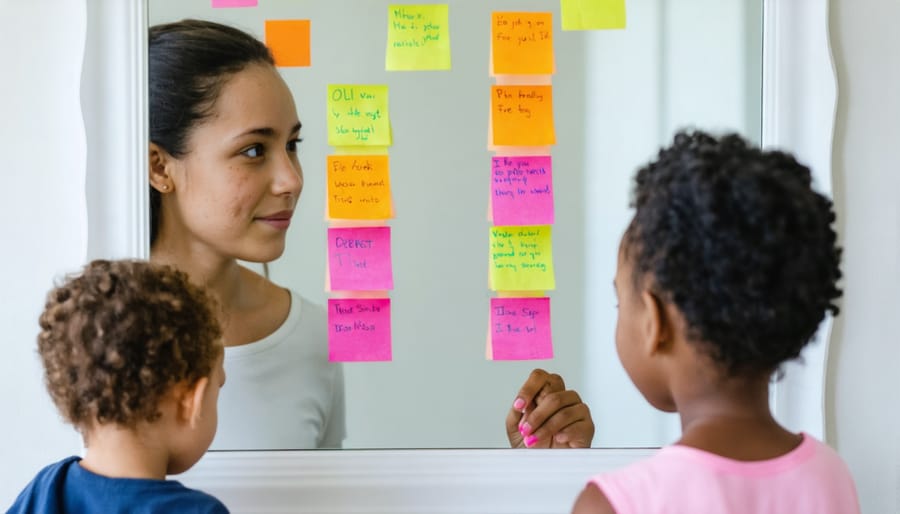Transform negative self-talk by catching critical thoughts the moment they arise and replacing them with balanced, realistic alternatives. When your child says “I can’t do this,” guide them to add the word “yet,” turning self-doubt into an opportunity for growth. This simple shift supports their emotional well-being and builds resilience.
Create a “thought detective” game where children learn to question negative assumptions, gather evidence for and against their self-critical beliefs, and develop more accurate self-assessments. Model this process by sharing age-appropriate examples from your own life, demonstrating how everyone faces internal criticism and can learn to overcome it.
Practice self-compassion exercises together, teaching children to speak to themselves with the same kindness they’d show a friend. This foundation of self-acceptance helps children develop healthier thought patterns and stronger emotional regulation skills, setting them up for long-term mental wellness.
Recognizing Negative Self-Talk in Children

Common Negative Self-Talk Patterns
Children often express negative self-talk in various predictable patterns. You might hear phrases like “I’m not good at anything” or “Nobody likes me” from a child struggling with these thoughts. Many children use absolute statements such as “I always mess up” or “I’ll never be able to do this” when facing challenges.
Another common pattern is comparing themselves unfavorably to others, saying things like “Everyone else is better than me” or “My sister is the smart one.” Some children engage in catastrophic thinking, jumping to worst-case scenarios: “If I make one mistake, everyone will laugh at me.”
Self-blame is also frequent, with children taking responsibility for things beyond their control: “It’s my fault mom and dad are arguing” or “If I were better, this wouldn’t happen.” You might notice some children using harsh self-criticism like “I’m so stupid” or “I’m the worst” when they make minor mistakes.
Watch for non-verbal signs too, such as refusing to try new activities, giving up quickly, or showing visible frustration when facing challenges. These behaviors often accompany negative self-talk patterns and signal that a child might need support in developing a more positive inner dialogue.
The Impact on Mental Health
When children engage in frequent negative self-talk, the impact on their mental health can be significant and long-lasting. As children internalize these negative thoughts, their self-confidence often takes a noticeable dip, making them hesitant to try new things or take on challenges. Many begin to develop a fear of failure, which can lead to increased anxiety in various situations, from classroom activities to social interactions.
Dr. Sarah Chen, a child psychologist, notes that persistent negative self-talk can act like a self-fulfilling prophecy. “When children constantly tell themselves they’re not good enough, they begin to believe it and act accordingly,” she explains. This pattern can affect their academic performance, friendship-building abilities, and overall emotional well-being.
Parents often notice changes in their children’s behavior, such as withdrawal from activities they once enjoyed, increased irritability, or trouble sleeping. These signs frequently accompany the internal struggle with negative thoughts. The good news is that with early recognition and proper support, children can learn to challenge and change these thought patterns, developing stronger emotional resilience and a healthier self-image.
Building a Positive Self-Talk Foundation
Age-Appropriate Tools and Techniques
Different age groups require distinct approaches to address negative self-talk effectively. For young children (ages 3-6), simple tools like stuffed animal friends can help them navigate big emotions and practice positive self-talk. Try using puppet play or creating a “feelings superhero” who fights off negative thoughts with special powers.
For school-age children (7-11), visual aids work well. Create a “thought detector” journal where kids can draw or write their negative thoughts on one page and positive alternatives on the opposite page. Emotion cards and positive affirmation mirrors can help them recognize and challenge unhelpful thinking patterns.
Tweens and teens (12-17) benefit from more sophisticated techniques like the “evidence detective” method, where they collect proof that challenges their negative self-talk. Journaling apps, mood trackers, and guided meditation recordings designed specifically for adolescents can provide private, age-appropriate support.
A particularly effective technique for all ages is the “pause and replace” method. Teach children to pause when they notice negative self-talk, take a deep breath, and replace the thought with a more balanced one. For younger children, this might involve using a physical “pause button” toy, while older kids can use mental visualization techniques or smartphone apps.
Remember to adapt these tools based on your child’s interests and comfort level, making the process feel natural and engaging rather than forced.

Creating a Supportive Environment
Creating a supportive environment at home is crucial for helping children develop positive self-talk patterns and build essential coping skills. Start by modeling positive self-talk yourself – children learn by example, and they’re always listening to how you speak about yourself and others.
Make your home a safe space where mistakes are viewed as learning opportunities rather than failures. When your child makes a mistake, respond with understanding phrases like “That’s okay, we all make mistakes” or “Let’s figure out what we can learn from this.” This helps replace their negative self-talk with more constructive thoughts.
Celebrate effort over perfection by acknowledging your child’s process rather than just the outcome. Simple phrases like “I saw how hard you worked on that” or “You didn’t give up even when it was difficult” can help build resilience and positive self-image.
Create regular check-in times where your child feels comfortable sharing their thoughts and feelings without judgment. This might be during bedtime routines, car rides, or while doing activities together. Listen actively and validate their emotions while gently challenging negative self-statements.

When to Seek Professional Help
While many strategies can help manage negative self-talk at home, certain situations signal the need for professional support. Watch for signs like persistent sadness lasting more than two weeks, withdrawal from activities your child usually enjoys, or significant changes in sleep or eating patterns. If negative self-talk includes expressions of self-harm or hopelessness, seek immediate professional help.
Professional intervention may also be necessary when negative self-talk interferes with daily activities, schoolwork, or relationships. A mental health professional can provide specialized tools and techniques tailored to your child’s specific needs. Remember, seeking help isn’t a sign of failure – it’s a proactive step toward supporting your child’s emotional well-being.
Consider consulting a child psychologist or counselor if your attempts to help aren’t showing improvement after several weeks, or if you notice your child’s anxiety or depression symptoms worsening. Many families find that early professional intervention leads to better outcomes and stronger coping skills for the future.
Supporting children through their journey of overcoming negative self-talk is an ongoing process that requires patience, consistency, and compassion. By staying attuned to their emotions, practicing positive reinforcement, and maintaining open communication, we can help build their emotional resilience. Remember that every small step counts, and with the right support system, children can develop healthier thought patterns and stronger self-esteem. If concerns persist, don’t hesitate to seek professional guidance – you’re not alone in this important journey of nurturing your child’s emotional well-being.







